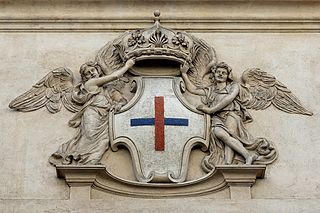
The Sisters of Mercy is a religious institute of Catholic women founded in 1831 in Dublin, Ireland, by Catherine McAuley. As of 2019, the institute has about 6200 sisters worldwide, organized into a number of independent congregations. They also started many education and health care facilities around the world.

The Trinitarians, formally known as the Order of the Most Holy Trinity and of the Captives, is a mendicant order of the Catholic Church for men founded in Cerfroid, outside Paris, in the late 12th century. From the very outset, a special dedication to the mystery of the Holy Trinity has been a constitutive element of the order's life.

The Sisters of St. Joseph, also known as the Congregation of the Sisters of St. Joseph, abbreviated CSJ or SSJ, is a Roman Catholic religious congregation of women founded in Le Puy-en-Velay, France, in 1650. This congregation, named for Saint Joseph, has approximately 14,000 members worldwide: about 7,000 in the United States; 2,000 in France; and are active in 50 other countries.
The Congregation of the Sisters of St. Joseph of Bourg grew out of the Congregation of the Sisters of St. Joseph of Lyon which had been disbanded during the French Revolution. The Sisters of Saint Joseph was revived as a congregation in 1807 at Lyons, during the Napoleonic regime through the efforts of Mother Saint John Fontbonne. In 1819 a daughter house was established in Bourg, which became an independent congregation in 1823. In 1977 the United States provinces of the Bourg congregation separated to form the Sisters of Saint Joseph of Medaille. In 1996 the Bourg congregation re-joined the founding congregation of Lyon, as part of the latter's European Province.
The Sisters of Saint Joseph of Medaille aka Congregation of the Sisters of St. Joseph of Bourg was a Roman Catholic congregation of women. Its forebear, the Congregation of Sisters of Saint Joseph was started in Le Puy, France by the Jesuit Jean Pierre Médaille and accepted by the bishop, Monsignor de Maupas, on October 15, 1650. The Congregation of Saint Joseph was disbanded during the French Revolution. It was revived in 1807 at Lyon, during the Napoleonic regime through the efforts of Cardinal Fesch and Mother Saint John Fontbonne. In 2007 the Sisters of Saint Joseph of Medaille merged with six other congregations to form a new congregation called the Congregation of Saint Joseph.
Holy Trinity College Bromley was an all-girls infant, junior and senior school from the mid 19th century to December 2005 located in the London Borough of Bromley, England.

Augustinian nuns are the most ancient and continuous segment of the Roman Catholic Augustinian religious order under the canons of contemporary historical method. The Augustinian nuns, named after Saint Augustine of Hippo, are several Roman Catholic enclosed monastic communities of women living according to a guide to religious life known as the Rule of St. Augustine. Prominent Augustinian nuns include Italian mystic St. Clare of Montefalco and St. Rita of Cascia.

Mary Euphrasia Pelletier, born Rose Virginie Pelletier, was a French Roman Catholic nun, best known as the foundress of the Congregation of Our Lady of Charity of the Good Shepherd.

The Order of Our Lady of Charity is a Roman Catholic monastic order, founded in 1641 by John Eudes, at Caen, France. There are two branches of the congragation: contemplative, and apostolic, involved in ministries primarily with women and children around the world.

Eliza Maria Gillespie, also known by her religious name Mary of St. Angela, was an American religious sister, mother superior, and foundress of many works of the Sisters of the Holy Cross in the United States.
Jeanne Fontbonne, more commonly known by her name in religion Mother St. John Fontbonne, was a French religious sister. She founded the Congregation of the Sisters of St. Joseph of Lyon in 1808 and served as its first Superior General.

The Religious of Jesus and Mary, abbreviated as R.J.M., form a Roman Catholic religious congregation of women dedicated to the education and service of the poor. An institute of consecrated life of pontifical right, the congregation was founded at Lyon, France, in October 1818, by Claudine Thévenet.
The Sisters of the Child Jesus are Religious Sisters founded in 1676 in Le Puy-en-Velay, France, by Anne-Marie Martel (1644–1673) to care for those in need. Divided among various independent religious congregations following the same spirit and tradition, they serve around the world. Since 1903, they have used the postnominal initials of R.E.J..
The Sisters of St. Anne (S.S.A.) is a Roman Catholic religious institute, founded in 1850 in Vaudreuil, Quebec, Canada, by the Blessed Marie Anne Blondin, S.S.A., to promote the education of the rural children of the Province of Canada. Their vision is rooted and guided by Ignatian spirituality.
The Poor Sisters of St. Francis, also known as the Aachener Franziskanerinnen, are a religious congregation founded by the Blessed Mary Frances Schervier in 1845 in Germany. Their distinguishing emblem is a red cross with the Instruments of the Passion on it, which was originally embroidered on the scapular of their religious habits.

The Congregation Sisters of the Most Holy Trinity, also known as the Trinitarian Sisters of Rome, is a Roman Catholic religious congregation of religious sisters based in Rome, were founded in 1762.
The Sisters of the Society of Saint Pius X are a semi-contemplative order of religious sisters founded by Archbishop Marcel Lefebvre on September 22, 1974. The motherhouse is located in Saint-Michel-en-Brenne, France, with additional houses in Argentina, Australia, Belgium, Germany, Italy, Switzerland and the United States. As of 2018, the current Superior General is Mother Maria Jean Bréant.
Martha Mary O'Neill (1878–1972), known by her religious name as Mother Patricia, was an Australian nun who became superior general for the Australian Union of the Sisters of Mercy. She was born in Cork, Ireland, and emigrated with her family to Victoria, Australia, in 1886. She joined the Sisters of Mercy as a young woman, professing her vows in 1903. She became superior general of the newly formed Australian Union of the Sisters of Mercy in 1954, and served in this role for twelve years, retiring in 1966.

Mariana of the Most Holy Trinity whose given name was Mariana Allsopp González-Manrique was a Mexican Catholic religious sister who co-founded the congregation of the Trinitarian Sisters of Madrid with Francisco de Asís Méndez Casariego.

Marie-Eugénie Caps (1892-1931) was a French Catholic sister who founded the Congregation of the Missionary Sisters of the Holy Spirit or Spiritaines or Spiritan Sisters in January 1921, at the age of 28.













